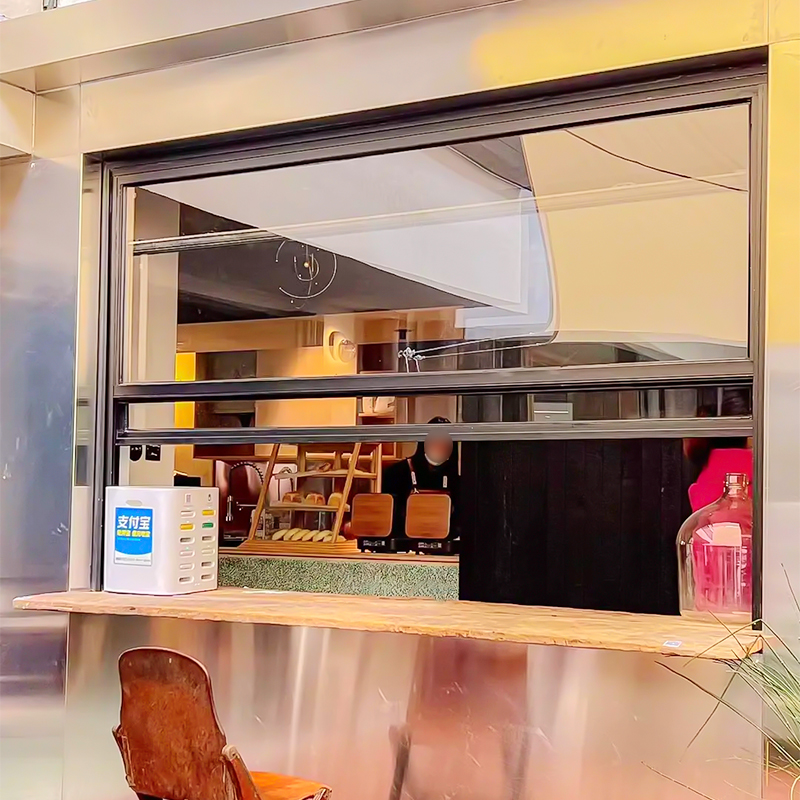How do manual lifting windows achieve reliable ventilation and emergency safety in powerless environments?
Release Time : 2025-10-08
In modern buildings, ventilation is not only a comfort requirement but also a critical factor for life safety. This is especially true in basements, equipment rooms, underground garages, distribution rooms, and storage spaces. In the event of a fire, hazardous gas leak, or power system failure, mechanical ventilation equipment often fails due to power outages. This can easily lead to the accumulation of toxic fumes and oxygen depletion, seriously threatening personnel safety and equipment operation. Manual lifting windows, with their lack of electrical power, simple and reliable structure, and intuitive operation, have become a crucial element for achieving natural ventilation and emergency smoke exhaust in powerless environments, earning them the nickname "the last line of defense for passive safety ventilation."
1. Purely mechanical structure, no power outages
The core advantage of manual lifting windows lies in their complete reliance on physical mechanical principles, without any motors, sensors, or external power sources. Users directly apply physical force to the window sashes, using mechanisms such as levers, pull cords, gears, or push rods to move them up and down. This "what you see is what you get" operation ensures 100% reliability even in extreme situations, such as earthquakes, fires, lightning strikes, or power outages. Unlike electric or smart windows, which can become completely locked after a power outage, manual lifting windows always maintain a manual override mechanism, ensuring that "the window can be opened, air can flow, and rescue efforts can be made" in critical moments.
2. Counterbalance System Enables Ease of Operation
Many people worry about the strain and difficulty of manually operating heavy glass windows. Modern manual lifting windows typically utilize a counterweight system or spring-assisted mechanism to cleverly offset the window's own weight. For example, a steel cable connects the window frame to a hidden counterweight, or a torsion spring or gas strut provides lift assistance. This allows windows weighing tens of kilograms to be easily raised and lowered single-handed and securely stopped at any height without the need for additional latches. This design ensures ease of operation while preventing injury from accidental falling, making it particularly suitable for non-professionals in emergency situations.
3. Complying with Mandatory Fire and Building Code Requirements
Manual lifting windows are often designated for use in such locations due to their reliability. Their precisely calculated effective opening area ensures timely exhaust of high-temperature smoke in the early stages of a fire, delaying flashover and buying valuable time for evacuation and fire rescue efforts. Some models have also passed fire tests, demonstrating a certain degree of fire resistance, further enhancing safety.
4. Multiple Sealing and Protection for Daily and Emergency Use
In daily use, manual lifting windows feature multiple sealing strips and drainage structures to ensure wind and rain protection. In an emergency, they can be fully opened with a simple click, enabling efficient cross-ventilation. Some high-end models also incorporate insect screens, anti-theft grilles, or position-limiting devices, ensuring ventilation while also ensuring safety and hygiene. Window materials, typically aluminum alloy or galvanized steel, are corrosion-resistant and deformation-resistant, and can withstand humid, hot, and chemical environments, maintaining full functionality over time.
5. Low Cost and Low Maintenance, Suitable for a Wide Range of Applications
Compared to complex electric ventilation systems, manual lifting windows offer a low initial cost, zero operating energy consumption, and virtually maintenance-free operation, making them particularly suitable for projects with limited budgets or limited O&M capabilities. Their "install-and-forget" design makes them a cost-effective solution for achieving basic ventilation safety in remote substations, rural pumphouses, and renovations of older buildings.
In summary, the manual lifting window, with its comprehensive advantages of "reliability even without electricity, simple operation, robust structure, and compliance," creates a solid lifeline in power outages or emergencies. It not only complements building ventilation systems but also safeguards safety. Amidst the wave of intelligent technology, this return to fundamental mechanical wisdom embodies the engineering philosophy of "redundant design" and "intrinsic safety"—when all electronic systems fail, humans can still open a window with their own hands, ushering in hope of life.
1. Purely mechanical structure, no power outages
The core advantage of manual lifting windows lies in their complete reliance on physical mechanical principles, without any motors, sensors, or external power sources. Users directly apply physical force to the window sashes, using mechanisms such as levers, pull cords, gears, or push rods to move them up and down. This "what you see is what you get" operation ensures 100% reliability even in extreme situations, such as earthquakes, fires, lightning strikes, or power outages. Unlike electric or smart windows, which can become completely locked after a power outage, manual lifting windows always maintain a manual override mechanism, ensuring that "the window can be opened, air can flow, and rescue efforts can be made" in critical moments.
2. Counterbalance System Enables Ease of Operation
Many people worry about the strain and difficulty of manually operating heavy glass windows. Modern manual lifting windows typically utilize a counterweight system or spring-assisted mechanism to cleverly offset the window's own weight. For example, a steel cable connects the window frame to a hidden counterweight, or a torsion spring or gas strut provides lift assistance. This allows windows weighing tens of kilograms to be easily raised and lowered single-handed and securely stopped at any height without the need for additional latches. This design ensures ease of operation while preventing injury from accidental falling, making it particularly suitable for non-professionals in emergency situations.
3. Complying with Mandatory Fire and Building Code Requirements
Manual lifting windows are often designated for use in such locations due to their reliability. Their precisely calculated effective opening area ensures timely exhaust of high-temperature smoke in the early stages of a fire, delaying flashover and buying valuable time for evacuation and fire rescue efforts. Some models have also passed fire tests, demonstrating a certain degree of fire resistance, further enhancing safety.
4. Multiple Sealing and Protection for Daily and Emergency Use
In daily use, manual lifting windows feature multiple sealing strips and drainage structures to ensure wind and rain protection. In an emergency, they can be fully opened with a simple click, enabling efficient cross-ventilation. Some high-end models also incorporate insect screens, anti-theft grilles, or position-limiting devices, ensuring ventilation while also ensuring safety and hygiene. Window materials, typically aluminum alloy or galvanized steel, are corrosion-resistant and deformation-resistant, and can withstand humid, hot, and chemical environments, maintaining full functionality over time.
5. Low Cost and Low Maintenance, Suitable for a Wide Range of Applications
Compared to complex electric ventilation systems, manual lifting windows offer a low initial cost, zero operating energy consumption, and virtually maintenance-free operation, making them particularly suitable for projects with limited budgets or limited O&M capabilities. Their "install-and-forget" design makes them a cost-effective solution for achieving basic ventilation safety in remote substations, rural pumphouses, and renovations of older buildings.
In summary, the manual lifting window, with its comprehensive advantages of "reliability even without electricity, simple operation, robust structure, and compliance," creates a solid lifeline in power outages or emergencies. It not only complements building ventilation systems but also safeguards safety. Amidst the wave of intelligent technology, this return to fundamental mechanical wisdom embodies the engineering philosophy of "redundant design" and "intrinsic safety"—when all electronic systems fail, humans can still open a window with their own hands, ushering in hope of life.








